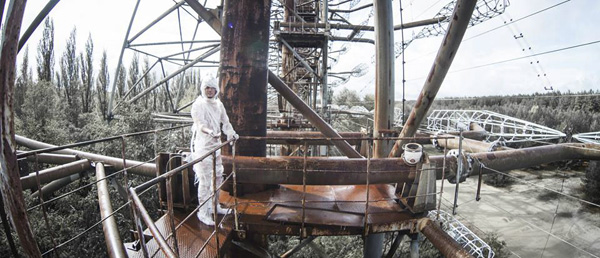(The writer of this review in no way intends to injure relations between the Ukraine, Belarus, and Russia.)
In recent years, natural disasters, violent atrocities, and political turmoil have been wrestling for headlines and the public’s attention. Any one instance of bad news becomes painfully easy to forget in a world of trending stories scrolled through with a fingertip. So it’s even easier to let distant events such as the Chernobyl nuclear accident of 1986 fade into the past, unless you were personally involved. Fedor Alexandrovich, a Ukrainian artist, has “radioactive strontium in his bones,” his mother says, because of that infamous nuclear meltdown, and he has made it his personal mission to not only remind the world of what happened but also solve the mystery of why it happened.
Alexandrovich makes a somewhat dubious protagonist. Little time is spent establishing his credentials. Someone says he’s a genius, and we see him storming around a theater workshop, but no real context to his work or ideology is given. Later, he admits to not being an expert in anything related to his investigation, so for a while his mission feels vague and hopeless. He walks around the Ukrainian ghost town of Chernobyl, evacuated because of the still dangerous levels of radiation from the damaged nuclear power plant, and gets stonewalled by former Soviet functionaries.
Soon his focus narrows. Starting in the 1970s, transmitters in the Soviet Union became known as the Woodpecker because of the sound their low-frequency radio waves made. The constant pecking was enough to cause a migraine, one expert says. Some speculated that the intent was mind control. The actual purpose was for the over-the-horizon transmissions to reflect off the ionosphere and travel the globe, picking up information from radio frequencies. This intelligence would allow for a Cold War scenario: if the United States fired its missiles, the U.S.S.R. would know in time to fire its own.
What first interests Alexandrovich is that the sound was being produced by the Duga, a giant antenna in Chernobyl, and second, that it didn’t work. The frequency jammed too many useful signals. Because of the Aurora Borealis, the frequencies couldn’t penetrate American air space. So the Duga, a seven billion ruble investment, was a bust. That bust was scheduled to become public knowledge in 1986 by a report on its lack of effectiveness, but when the meltdown happened, the Duga was shuddered without comment, just another casualty of the radiation. Could someone have ordered the accident to cover up the useless antenna?
Alexandrovich finds a suspect in the Soviet minister of communication, Vasily Shamshin, who staked his reputation on the Duga, and may have had his life on the line because of it. Shamshin is dead, and so he cannot answer the accusation, but plenty of others Alexandrovich interviews do. “Bullshit,” says one. Alexandrovich’s theory may be hard to believe, but so is what happens to him and to his cinematographer, Artem Ryzhykov, as their investigation collides with the turmoil in the Ukraine during the winter of 2014.
After Alexandrovich is threatened, he begins to fear for the life of his son. He wants to edit the film, to soften it. He insists on inserting a disclaimer, worded like the one that starts this review, and he gets it. Ryzhykov, meanwhile, is shot by police while photographing an anti-government protest in Kiev. The filmmakers begin to play cloak and dagger, hiding cameras from each other, aware that the documentary they’re making about radiation has become poisonous to the touch.
“Every tragedy must have a reason,” Alexandrovich says early on. It’s a theater artist’s belief. In the real world, it may be technically true, but the reason is so often unsatisfying, rarely the stuff of catharsis. Still, more convincing than the attempt to pin a meaningful reason to the Chernobyl tragedy is the eyewitness seat The Russian Woodpecker provides to a possible new catastrophe taking place in the same troubled land.

















Leave A Comment